
* The Westland company of the UK pursued a number of fighter concepts during the World War II era, beginning with the "Whirlwind" twin-engine fighter; then the "Welkin" twin-engine high-altitude fighter; and finally a single-engine fighter design that emerged in the postwar period as the "Wyvern" carrier-based strike aircraft. None of these machines were particularly successful and amount to an obscure chapter in aviation history. This document provides a history and description of the Whirlwind, Welkin, and Wyvern.

* With war in Europe becoming more likely through the 1930s, the British Royal Air Force (RAF) began to acquire improved combat aircraft in anticipation of the conflict. One avenue of effort led to the Hurricane and Spitfire single-engine fighters; a parallel effort focused on a heavy fighter, possibly powered by twin engines, carrying four French 20-millimeter Hispano cannon. In 1935, the British Air Ministry accordingly issued a requirement designated F.37/35 for such an aircraft; five aircraft manufacturers -- Boulton-Paul, Bristol, Hawker, Supermarine, and Westland -- came back with a total of eight proposals, some with a single engine, some with twin engines.
The most attractive of the bunch was the Westland "P.9", which had a low-mounted wing with a Rolls-Royce Kestrel K.25 -- later Peregrine -- water-cooled vee-twelve engine mounted under each wing; a twin-fin tail; a slender fuselage, with an all-round vision canopy and four Hispano cannon in the nose in a 2x2 arrangement; and taildragger landing gear. After consideration of finalists, two P.9 prototypes were ordered in February 1937.
Initial flight of the first prototype was on 11 October 1938, with Westland test pilot Harald Penrose at the controls, and the unarmed aircraft painted overall dark gray. The "Whirlwind", as it was named, seemed so promising that there was pressure to put it into production immediately, but the Air Ministry felt cautious about committing such an innovative aircraft to production until trials had proven its merit. By early 1939, it seemed safe to proceed, with an order placed for 200 machines, which would be followed by an order for 200 more. The first production "Whirlwind I" performed its initial flight in June 1940, with initial service deliveries a month later.
* The Whirlwind was designed by a team under the direction of W.E.W. "Teddy" Petter, later to design the Canberra jet bomber and the Gnat jet fighter / trainer -- the original P.9 designation stood for "Petter Number 9". As it emerged, the Whirlwind was still much like the original P.9 concept, aside from the fact that the twin tailfin was dropped in favor of a single tailfin, with a tailplane mounted high on the tailfin. Production machines added an "acorn" fairing at the intersection of the tailplane and tailfin; the initial prototype didn't have the fairing, presumably leading to buffeting. The second prototype and early production machines had a smaller acorn fairing. The twin tailfins had been abandoned when wind tunnel tests demonstrated airflow off the engines interfered with the tail control effect; the high tailplane was adopted to keep it out of the turbulent airflow.
The Whirlwind was of all-metal construction, with flush riveting, and featuring magnesium skinning on the rear fuselage. The control surface arrangement was conventional, with large one-piece Fowler flaps inboard and an aileron outboard on each wing, with the rear end of the engine nacelles hinging with the flaps; elevators; and a two-piece rudder, split to permit movement above and below the tailplane. Slats had been fitted on the outer wings at the outset as a stall protection measure, but they were soon locked down, having been implicated in an accident.

The supercharged Peregrine engines provided 660 kW (885 HP) each, with cooling ducts for radiators in the inner wings; the positioning of the radiators ensured that the cockpit was properly heated. The engines drove de Havilland three-bladed variable-pitch constant-speed propellers featuring prominent prop spinners. Each cannon had an ammunition store of 60 rounds. All landing gear assemblies had single wheels, with the main gear on dual struts and retracting backward into the engine nacelles; the tailwheel retracted. The canopy slid back to open.
___________________________________________________________________
WESTLAND WHIRLWIND:
___________________________________________________________________
wingspan:
13.72 meters (45 feet)
wing area:
23.23 sq_meters (250 sq_feet)
length:
9.98 meters (32 feet 9 inches)
height:
3.53 meters (11 feet 7 inches)
empty weight:
3,770 kilograms (8,310 pounds)
MTO weight:
5,165 kilograms (11,385 pounds)
max speed at altitude:
580 KPH (360 MPH / 315 KT)
service ceiling:
9,235 meters (30,300 feet)
range:
1,290 kilometers (800 MI / 695 NMI)
___________________________________________________________________
* In service, there were teething problems with the cannon and, more significantly, with the Peregrine engines. Pilots did find the Whirlwind's handling very pleasant, the machine having a light touch on the controls and few "funnies". Its performance was excellent at low altitude, allowing it to hold its own against German fighters. Performance did fall off at high altitude, and the Whirlwind also landed "hot", meaning it couldn't use shorter airstrips.
Few could have failed to appreciate just what a pretty aircraft the Whirlwind was, like something out of contemporary pulp sci-fi magazines. The problems, particularly with the engines, could have been at least partly addressed; however, development of the Whirlwind had been overly protracted, leaving it behind the learning curve, and then it ran into a wall when Rolls-Royce decided to stop working on the Peregrine engine in order to focus on its bigger cousin, the Merlin water-cooled vee-twelve. That stopped the Whirlwind dead, with production cut off at 112 machines, not counting the two prototypes. The last Whirlwind was delivered in January 1942. Ironically, the Whirlwind wasn't announced to the public until a month later -- despite the fact that the French and the Germans had been aware of it since before the outbreak of the war.
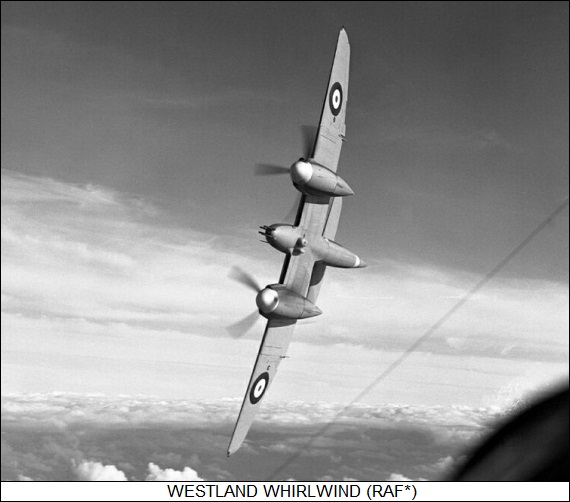
The Whirlwind only equipped two RAF squadrons, Number 137 and Number 263, who operated it in the low-level ground attack role, the machine being rigged to carry a 115-kilogram (250-pound) or 225-kilogram (500-pound) bomb under each wing. The Whirlwind fighter-bombers were named "Whirlibombers", and they proved highly effective. The machines were painted in white underneath and disruptive camouflage on top -- green and brown initially, then blue and brown. In June 1943, Number 137 Squadron turned in its Whirlwinds for rocket-firing Hawker Hurricanes, while Number 263 Squadron traded in its Whirlwinds for Hawker Typhoons in December 1943. One Whirlwind was stripped of its armament and painted blue, to be used as a Westland company hack for a short time in the postwar period, until it was scrapped in 1947.
A Whirlwind was experimentally fitted with twelve 7.9-millimeter (0.303-caliber) machine guns, while another was fitted with a single 37-millimeter cannon in an extended and modified nose. Westland came up with sketches of Whirlwind derivatives with Rolls-Royce Merlin or the later Griffin engines, even envisioning pusher configurations, but they never amounted to much more than back-of-the-envelope jottings -- the Whirlwind itself was built around relatively small engines, the Peregrine being only about 70% as heavy as a Merlin. The Whirlwind itself couldn't be fitted with larger engines, and a derivative that could would be a new machine.
The Whirlwind really wasn't needed: twin-engine long-range bomber escort fighters turned out to be a mirage, and in the fighter-bomber role the RAF had the excellent Bristol Beaufighter and de Havilland Mosquito. The Mosquito led to the superlative Hornet twin-engine fighter, which served in the postwar period and could be seen as embodying everything that might have ever been expected of the Whirlwind.
In the postwar period, Westland focused on production of helicopters, one of the company's stable being a license-built version of the Sikorsky S-55, confusingly also named the "Whirlwind". No Whirlwind fighters have survived to the present, though there has been talk of building a full-scale flying replica.
BACK_TO_TOP* Britain had experimented with technology for pressurized high-altitude aircraft in the prewar period, the most significant exercise being the flight of the General Aircraft LTD "GAL.41" demonstrator in the spring of 1939 -- this machine being a modification of a GAL ST.25 Monospar twin-engine airliner. GAL then offered a design concept for a twin-engine "Stratospheric Fighter" designated the "GAL.46" to the Air Ministry, this machine somewhat resembling a Messerschmitt Bf 110, being armed with four 20-millimeter cannon; it could also be used as a fast light bomber, with a bombload of four 225-kilogram (500-pound) bombs, or as a reconnaissance platform.
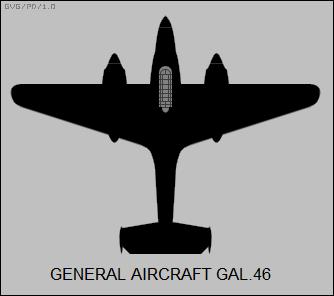
The Air Ministry had some interest in the GAL.46; at the time, under specification B.23/39 Britain was pursuing a high-altitude pressurized bomber, which emerged as the Vickers Wellington Mark V -- which featured a fully pressurized cabin, a little "pimple" dome for the pilot, and twin turbocharged Hercules radial engines. Three prototype Wellington Vs were built, the first flying in September 1940, and successfully demonstrated many core technologies for high-altitude flight. The Mark V was followed by the Wellington Mark VI, which was similar but had some improvements, including extended wingspan, and in particular new Rolls-Royce Merlin 60-series engines with two-stage supercharging. A total of 63 Wellington Mark VI bombers was built, though they saw little or no action; the Merlin 60 proved more important, being used very successfully in a range of aircraft, one of the most prominent being later models of the North American P-51 Mustang.
Further consideration of the GAL.46 led to issue of an F.4/40 specification in July 1940, dictating an interceptor with a top speed of 725 KPH (450 MPH / 390 KT) and an operational ceiling of 13,700 meters (45,000 feet). The GAL.46 design wasn't selected, however; Westland had responded with a design, the "P.14", with a vague resemblance to a Whirlwind with stretched wings, one seat, a pressurized fuselage, Merlin Mark 60-series engines, and four 20-millimeter cannon -- F.4/40 had specified six cannon but four were judged adequate. Go-ahead was given for prototype development. The design was tweaked the next year in response to a modified spec, designated F.7/41, with Vickers-Armstrong also developing a high-altitude fighter, the "Type 432", to that spec. The effort was boosted by the fact that from the fall of 1940, the UK was overflown by high-altitude Junkers Ju 86P reconnaissance aircraft, increasing official interest in a machine to shoot the intruders down.
The prototype "Welkin", as the Westland fighter was named -- it was an Old English word meaning "sky" -- performed its initial flight on 1 November 1942 with test pilot Harald Penrose at the controls, this machine being powered by Merlin 61 engines providing 1,165 kW (1,565 HP). The odd thing about the development of the Welkin was that, by the time of its first flight, Britain already had a high-altitude fighter.
In the summer of 1942, de Havilland had rolled out the prototype of a high-altitude bomber with cabin pressurization; in response to Air Ministry concerns, the prototype was quickly converted into a high-altitude fighter, the "Mosquito Mark XV", with four 7.9-millimeter (0.303-caliber) machine guns in a belly tray and extended "pointy" wingtips. This machine working out well, it was followed by four production aircraft. They never saw action, the Luftwaffe having given up on high-altitude overflights of the UK by that time. The bottom line, however, was that a validated high-altitude fighter design was available if the need arose for it.
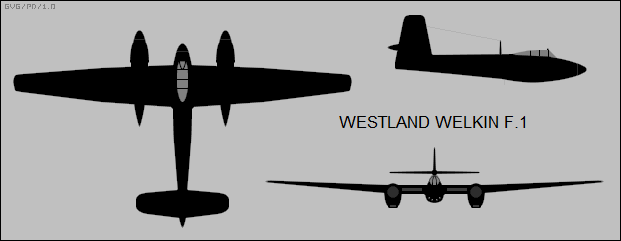
* The Welkin program continued, however, it seems out of bureaucratic inertia. Following the two prototypes, a hundred production "Welkin Fighter Mark I (F.I)" machines were built, the first flying in August 1943. The production Welkin was a mid-wing aircraft, with the tailplane set a small distance up on the tailplane; it was built mostly of aircraft aluminum, with some magnesium. The machine was powered by twin Merlin engines, the engines being "handed", with a Merlin 72 or 76 on the left and a Merlin 73 or 77 on the right, with the right engine fitted with a blower to pressurize the cockpit. The engines drove four-bladed variable-pitch constant-speed propellers, originally built by de Havilland and then by Rotol.
___________________________________________________________________
WESTLAND WELKIN:
___________________________________________________________________
wingspan:
21.34 meters (70 feet)
wing area:
42.73 sq_meters (460 sq_feet)
length:
12.65 meters (41 feet 6 inches)
height:
4.8 meters (15 feet 9 inches)
empty weight:
6,540 kilograms (14,225 pounds)
MTO weight:
9,000 kilograms (19,840 pounds)
max speed at altitude:
625 KPH (390 MPH / 335 KT)
service ceiling:
13,400 meters (44,000 feet)
range:
2,415 kilometers (1,500 MI / 1,305 NMI)
___________________________________________________________________
The wing, despite its extended span, had only a single spar. The wings stowed four fuel tanks with a total capacity of 1,820 liters (480 US gallons); there was a small tank with a capacity of 320 liters (84.4 US gallons) in the center fuselage, but it was only used for ferry flights. A 900-liter (237.5-US gallon) drop tank could also be carried under each outer wing for ferry flights. The landing gear arrangement was very similar to that of the Whirlwind, all gear with single wheels, the main gear on twin struts retracting back into the engine nacelles, the tailwheel being retractable. The four 20-millimeter cannon were mounted in a tray under the forward fuselage, with 138 rounds per gun for each inner gun and 145 rounds per gun for the outer guns. The arrangement of the cannon permitted installation of the canopy well forward, giving the pilot a good front view. The canopy slid back to open.
Trials went well enough at first -- except for minor problems, most notably the fact that the pressurization system turned the cockpit into a cooker. Maneuverability wasn't the best, but nobody could have thought an aircraft with such a wide wingspan would have a snappy rate of roll. However, once dive tests began, it quickly became obvious that something was wrong, with the machine suffering severe vibration when it hit about 800 KPH (500 MPH / 435 KT). Penrose said that in its "milder" forms it was like "tobogganing down a flight of stairs on a tea tray."
What the Welkin was encountering was "compressibility stall", with the airflow over the wings reaching the speed of sound at the thickest point, resulting in shock waves. The Americans had run into the phenomenon, most notably on the Lockheed P-38 Lightning twin-engine fighter; Hawker's chief test pilot, George Bulman, visited the USA and was briefed on it, with Bulman writing a booklet explaining the matter for the British aviation community. The Americans had found that compressibility could be dealt with by reducing the wing thickness / chord ratio. Unfortunately, there was no way to redesign the Welkin's wings to eliminate the problem, and so any target that went into a dive could easily escape.
Although it appears that RAF service squadrons did get their hands on a few Welkins, the type never really got into operational service, and most were quickly scrapped -- apparently 25 of the 100 production machines were parked and then disposed of. There was simply no need for it, and to the extent there potentially was, the Mosquito could do the job better. Some Welkins were used for test and trials into the early postwar period; one was converted into a "Welkin NF.II" night fighter, with AI.VIII radar in a thimble nose and two seats, the radar operator facing backwards. Westland performed some paper studies on a turbojet-powered derivative of the Welkin, the "J.8", with a wide-span tailplane turning into a "twin wing" or "Delanne" configuration -- named after Maurice Delanne, a French aircraft designer who was one of its advocates -- but it never came close to happening.
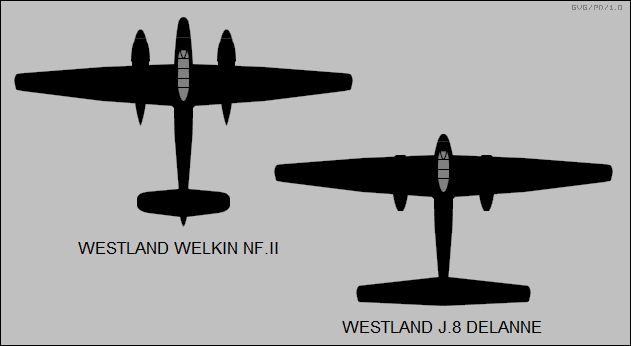
* The Vickers 432 didn't get as far as the Welkin. The Type 432 performed its first flight on 24 December 1942, with company test pilot D.W. "Tommy" Lucke at the controls. As it emerged, the Type 432 looked very much like a Mosquito from the side, being powered by twin Merlin 61 engines, driving four-bladed props, and with tailwheel landing gear. However, unlike the wood composite Mosquito, the Type 432 was made of metal; it also had a pimple canopy like that of the Wellington Mark V/VI, and its wings had an exaggerated elliptical profile. Test flights seemed promising, but there was no need for the machine, and the second prototype was canceled. The Type 432 performed trials into 1945, and was then scrapped.
BACK_TO_TOP* Westland never managed to get a fighter into full operational service during World War II. Along with the Whirlwind and the Welkin, the company came up with design concepts for a number of other piston and jet-propelled fighters, but none were built. However, company work did lead to the development of a prop fighter that did see service in the postwar period.
In 1944, Teddy Petter came up with concepts for a fighter to be based on the new Rolls-Royce "Eagle" 24-cylinder "H" configuration piston engine, one concept with the engine conventionally placed in the nose, and one with it placed in mid-fuselage -- driving a nose prop via a driveshaft, as along the lines of the American Bell P-39 Airacobra. The concepts also included a variant powered by a turboprop engine, then referred to as a "propeller turbine". The designs included both RAF and naval configurations. The Air Ministry gave the go-ahead for more advanced investigation of the "P.10" or "W.34", as it was designated.
The RAF never became keen on the W.34, but the Admiralty was interested enough to award a contract for six prototypes under specification N.11/44. The machine was envisioned as "torpedo fighter", capable of air combat or strikes with torpedoes and other offensive stores. These prototypes were to be powered by the Eagle engine. Westland also came up with a similar design powered by the Rolls-Royce RB.39 Clyde turboprop; following issue of the appropriate specification, N.12/45, three prototypes of the "W.35" were ordered in early 1946, with one to be powered by the Clyde and the other two to be powered by the Armstrong-Siddeley Python turboprop. Since neither engine was in production, it was seen as wise to evaluate alternatives. There were also some studies of a turbojet variant, the "W.36", to be powered by a Rolls-Royce AJ.65 (later Avon) engine, but it never got out of the paper stage. By that time, Petter had left Westland for English Electric, with the design effort at Westland taken over by John Digby.
* Analysis showed that the Eagle would be substantially heavier than the Clyde, with an Eagle-powered aircraft being correspondingly heavier as well, resulting in poor performance. That meant turboprop propulsion was the way of the future, but work on the Eagle-powered W.34 wasn't abandoned immediately. Initial flight of the first W.34 prototype -- now the "Wyvern Mark I", a wyvern being a Nordic flying dragon, was on 16 December 1946, with Harald Penrose at the controls.
This machine and the second prototype were unarmed landplane variants, with fixed wings and no arresting gear; the Eagle 22 engine provided an impressive 2,610 kW (3,500 HP) and drove a Rotol contraprop system with dual four-blade props, the contraprop arrangement being intended to cancel torque. The first prototype was lost in an air accident in 1947, test pilot Peter Garner being killed when he tried to make a forced landing in a field. The second prototype was then modified with a tailplane featuring dihedral, instead of being flat as originally fitted, with dive brakes fitted above the wings.

The remaining four prototypes were fully navalized, with folding wings and arresting hook, as well as armed with four Hispano Mark V 20-millimeter cannon in the wings. One was initially fitted with a six-blade de Havilland contraprop instead of the eight-blade Rotol contraprop, though it was later updated to the Rotol contraprop. There was some interest early on in going on to production, with 20 "Wyvern Torpedo Fighter Mark I (TF.1)" machines ordered in August 1946, but in reality only 7 were actually built. They never saw operational service, though they were used for trials. The Eagle engine was then abandoned after only a few dozen had been built.
* The first turboprop-powered W.35 prototype, designated "Wyvern TF.2", performed its initial flight on 18 January 1949, again with Penrose at the controls; it was a short hop, the cockpit filling up with smoke, due to fuel leaking onto the engine exhaust pipe. This machine was powered by the Clyde engine, driving a 6-blade Rotol contraprop. It was followed before the end of the year by the two Python-powered machines, which were longer and heftier than the Clyde machine since the Python was bigger. Trials dictated fit of a taller tailfin, as well as the tailplane with dihedral. One of the two Python machines was lost in a landing accident in October 1949 -- which killed pilot Mike Graves, along with three people in a house beyond the end of the runway at Yeovil.
The Python-powered variant was seen as promising enough to lead to a contract for 20 pre-production TF.2 machines, the first flying on 16 February 1950, though only 13 would be built in all. The pre-production machines were similar to the original TF.2 prototypes, but with changes incorporated in the prototypes during evaluation and some new fixes, most prominently a Python 2 engine that addressed the slow throttle response of the Python 1 of the prototypes -- by the simple measure of running the Python 2 at constant RPM, and using prop pitch to control power transfer. The Python 2 would have problems of its own, however, occasionally suffering from violent and damaging engine surges. The TF.2 also featured a Martin-Baker Mark 1B ejection seat, replacing the ML-built ejection seat of the prototypes.
There was work in parallel to put together a two-seat conversion trainer variant, the "W.38" or "Wyvern Trainer Mark 3 (T.3)", as covered by specification T.12/48. It was effectively a TF.2 with a modified fuselage for tandem cockpits, each cockpit having its own sliding canopy and each with an ejection seat; the instructor in the rear seat had a periscope to improve forward view. The T.3 prototype performed its initial flight on 11 February 1950, but official interest had faded and it didn't lead to production. The T.3 was written off in the fall of 1950 after a forced landing in a marsh.
However, an initial production order for the "Wyvern Strike Mark 4 (S.4)" was placed in 1951, the change in designation to "Strike" demonstrating that all pretensions of the Wyvern as an air combat fighter had been abandoned. A total of 98 was built, including 7 TF.2 pre-production machines completed to S.4 spec -- which is why the TF.2 pre-production build only ran to 13 aircraft -- and four TF.2 pre-production machines updated to S.4 spec.
There was some thought of building a follow-on "Wyvern S.5E" with a Napier E.141 Double Eland "twin-pac" turboprop engine and wingtip fuel tanks, but it didn't happen, and the S.4 was the end of the line. The S.4 entered service in 1953, though it didn't perform its first operational carrier cruise until 1954. In parallel, a number of the various Wyvern prototypes soldiered on in trials well into the 1950s.
BACK_TO_TOP* The Wyvern S.4 was of all-metal construction, made mostly of aircraft aluminum, with a low straight wing and generally conventional tail arrangement, plus fully retractable landing gear. The pilot sat on a Martin-Baker Mark 1B ejection seat -- later updated to the Mark 2B -- under a bubble-type canopy, with the "humpbacked" configuration of the aircraft giving a good forward and all-round view, with the canopy sliding back to open. Later production featured a canopy with an armor glass windscreen and a metal instead of plexiglas aft section.
The wings were of inverted gull configuration, with a 1-degree anhedral droop inboard and 6-degree dihedral outboard, with the outboard wings folding up hydraulically; naval prototypes and early production also had wingtips that folded up to provide clearance in the carrier hangar deck. The flight control arrangement was generally conventional, including flaps, ailerons, elevators, and rudder -- though there were split flaps on the outer wings that could also serve as dive brakes. As mentioned, while the tailplane had been flat on early prototypes, it had a noticeable dihedral on late prototypes and the production S.4 machines; the S.4 also had little rectangular "finlets" towards the tailplane tips, these finlets initially being absent on the TF.2 machines built or updated to S.4 spec. All gear assemblies had single wheels, the main gear hinging from the wings in toward the fuselage; the main gear struts telescoped inward on retraction to allow the gear to fit in the wing. There was a stinger-type arresting hook in the tail.

Early production of the Wyvern S.4 was powered by an Armstrong-Siddeley Python 2 turboprop, though as mentioned the Python 2 had some nasty habits; it was quickly updated to the Python 3, featuring a Rotol-built engine control unit that tamed the beast. The Python drove an eight-bladed Rotol contraprop and featured split exhausts below the cockpit, just above the rear edge of the wings; the engine provided 2,740 kW (3,670 SHP) of power, with the exhaust also providing 5.12 kN (520 kgp / 1,150 lbf) thrust. There were two fuel tanks in the fuselage, plus a fuel tank in each inner and outer wing -- for a total of six tanks, with an overall capacity of 2,323 liters (613 US gallons).
___________________________________________________________________
WESTLAND WYVERN S.4:
___________________________________________________________________
wingspan:
13.41 meters (44 feet)
wing area:
32.98 sq_meters (355 sq_feet)
length:
12.88 meters (42 feet 3 inches)
height:
4.8 meters (15 feet 9 inches)
empty weight:
7,075 kilograms (15,600 pounds)
MTO weight:
11,135 kilograms (24,550 pounds)
max speed at sea level:
615 KPH (385 MPH / 335 KT)
service ceiling:
8,535 meters (28,000 feet)
range:
1,465 kilometers (910 MI / 790 NMI)
___________________________________________________________________
Internal armament consisted of four Hispano Mark V cannon, one inboard and one outboard of each wing fold, with 200 rounds per gun. There were seven stores attachments: one on the centerline, one under each inner wing, and two rocket launch rails under each outer wing. The centerline pylon could carry a 51-centimeter (20-inch) torpedo, a 450-kilogram (1,000-pound) bomb, or a 682-liter (180 US gallon) external tank. The inboard pylon could handle a 450-kilogram bomb or 455-liter (120 US gallon) external tank, while the two rocket rails could handle up to a total of four "60-pounder" (27.2-kilogram) rockets, stacked two to a rail. The inboard pylon could be swapped for two rocket rails as well, giving the Wyvern a total rocket warload of 16 rockets.
* The Wyvern was regarded as pleasant to fly, but the turboprop powerplant wasn't completely satisfactory: except at low altitude, the S.4 was slower than the Eagle-powered TF.1, and the S.4 also had an inferior rate of climb. It equipped a total of four service squadrons, though the maximum number of squadrons operating it at any one time was three, and generally only two.
The Wyvern's service life was short, its only real distinction being combat service in the 1956 Anglo-French-Israeli seizure of the Suez Canal under Operation MUSKETEER, with carrier-based Wyverns contributing with airstrikes using 450-kilogram (1,000-pound) bombs, and battlefield close support with rockets and cannon fire. Although MUSKETEER was tactically successful, with the occupation force quickly brushing aside Egyptian resistance, the exercise was a political fiasco, with the Americans bluntly ordering the British to get out. The British did, and the French were forced to follow.
The Wyvern began to be drawn down in 1957 and was out of service by 1958. Given its limited service career, it is hard to know what to make of it. A simple assessment is that it was too little and too late, obsolescent when it was introduced and quickly left behind by technological advance. All the Wyverns were scrapped, except for one, ironically an Eagle-powered TF.1 prototype, which now resides at the Royal Navy Fleet Air Arm Museum in Yeovilton.
BACK_TO_TOP* Although Westland's efforts to build an advanced fighter were hardly marked by success, at least the Whirlwind remains widely recognized -- even though not much more than a hundred were made, and it had a relatively short service life. After all, about the same number of Wyverns were built, and it's generally forgotten; one suspects that the Whirlwind is remembered simply because it was stylish. In any case, at least Westland proved unambiguously successful in building helicopters in the postwar period.
I have to add as a footnote that modeler came up with a "what-if" concept based on the Whirlwind, the "Singlewind", which was a single-engine Whirlwind with an asymmetric layout. I have to give the modeler points for imagination and ingenuity, though I do wonder if he was certifiably crazy. Of course, having embraced the craziness, I had to think: Well, if we can have a Singlewind, then why not a Whirlylightning? Or a Twin Whirlwind? Or a Wasp radial Whirlwind?
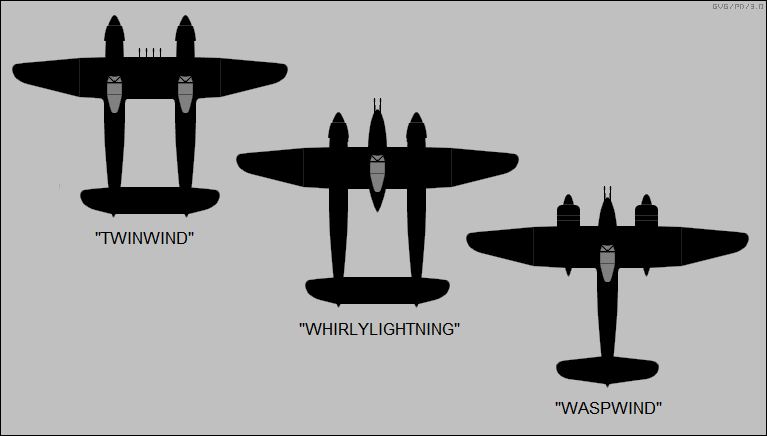
As I found out later, somebody had done a Whirlylightning model, too. No doubt Twinwind and Waspwind models are lurking out there as well.
* Sources include:
* Revision history:
v1.0.0 / 01 jan 11 v1.0.1 / 01 dec 12 / Review & polish. v1.0.2 / 01 nov 14 / Review & polish. v1.0.3 / 01 oct 16 / Review & polish. v1.0.4 / 01 sep 18 / Review & polish. v1.0.5 / 01 jul 20 / Review & polish. v1.0.6 / 01 may 22 / Review & polish. v1.0.7 / 01 apr 24 / Review & polish.BACK_TO_TOP
